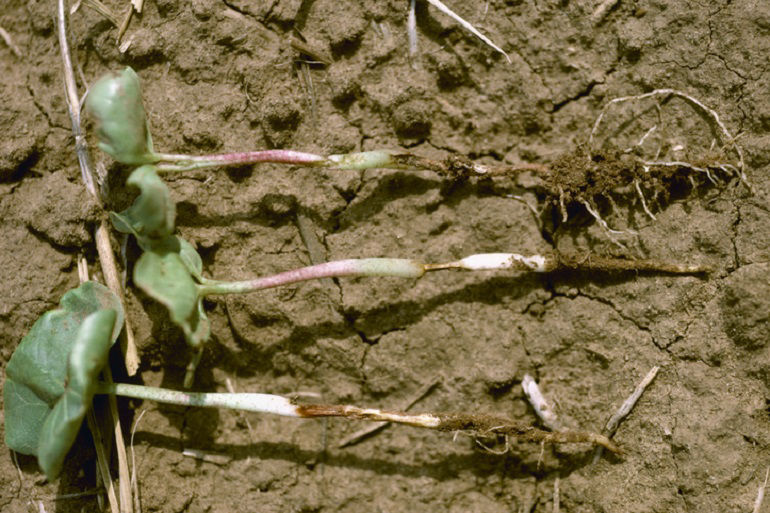Don’t Let Rhizoctonia Dig into Cotton Profits
September 4, 2019

Among the seedling diseases that attack cotton crops each year, Rhizoctonia ranks as one of the most common. Caused by the fungus Rhizoctonia solani, this soilborne disease develops primarily in early-planted fields, attacking cotton plants at the soil level and causing pre- and postemergence damping off. Rhizoctonia is part of a seedling disease complex that also includes the fungi Pythium spp., Thielaviopsis basicola and Fusarium spp.
Rhizoctonia disease infection varies with the growth stages of the cotton seedlings as it progresses. Sometimes the Rhizoctonia fungus acts alone; sometimes it acts in concert with the other fungi in the seedling disease complex.
Identification and Lifecycle
Cotton seedlings are prone to infection from Rhizoctonia when excessive moisture reduces plant growth rate, particularly in early spring. Even so, Rhizoctonia can still develop over a wide range of soil moisture conditions and temperatures, including 75 to 90 degrees F with only moderate moisture.
The soreshin stage of Rhizoctonia seedling disease appears as reddish-brown sunken lesions below and above the ground. Rhizoctonia lesions girdle the stem and eventually causes emerged seedlings to collapse, a condition often referred to as “damping off.” Damping off is caused by a number of different disease pathogens that weaken and sometimes kill seedlings before or after germination.
Other symptoms of Rhizoctonia include seed decay and seedling root rot that occurs before and after plant emergence. After plants reach 6 to 8 inches in height, cotton stems become woody, and Rhizoctonia disease will not be a problem unless stems are injured.
Crop Damage
When infection with Rhizoctonia results in complete girdling of the stems, cotton seedlings may die. If cotton seedlings survive the disease, mature plants are weakened and will continue to show the soreshin lesion marks at the stem base.
Research shows that high levels of infection from Rhizoctonia and the other fungi – Pythium, Thielaviopsis and Fusarium – in the disease complex can slow cotton maturity up to four weeks and reduce annual yield by 5 percent or more, according to North Carolina State University. The cost of Rhizoctonia disease to growers is even greater when it’s necessary to replant to achieve uniform stands.
Managing Rhizoctonia Disease
Although management efforts can help reduce the incidence and impact of Rhizoctonia, no single approach is highly effective to completely control this common disease of cotton and other row crops. Thus, a combination of preventive measures for managing cotton diseases and disease resistance is key, including scouting, cultural practices, seed selection, seed treatments and fungicides.
Bayer Solutions
For cotton-growing areas with a history of disease pressure and/or conditions that are conducive to seedling disease problems, growers can maximize their stands by planting in optimal soil temperatures and protect their cottonseed investment with a premium fungicide seed treatment such as Trilex® Advanced. It protects against a broad range of cotton seedling diseases, including Fusarium, Rhizoctonia, Pythium and Thielaviopsis basicola and is the preferred fungicide partner for Aeris® insecticide/nematicide seed treatment.
View our SeedGrowth section to learn more about cottonseed treatments from Bayer that offer advanced protection against nematodes and early-season insect pests, as well as seed and seedling diseases, or contact your local Bayer representative.